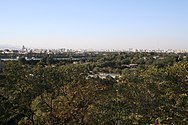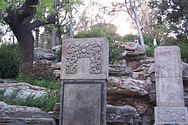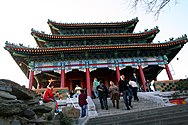Jingshan Park
| Jingshan Park | |
|---|---|
 One of the peaks of the Jingshan | |
 | |
| Type | Urban park |
| Location | Beijing, China |
| Coordinates | 39°55′25″N 116°23′26″E / 39.92361°N 116.39056°E |
| Area | 0.23 km2 (0.089 sq mi) |

Jingshan (Chinese: 景山; pinyin: Jǐngshān; lit. 'Prospect Hill') is an artificial hill in Beijing, China. Covering an area of more than 230,000 m², Jingshan is immediately north of the Forbidden City on the central axis of Beijing.[1] As a result, it is administratively part of both the Xicheng District and the Dongcheng District. Originally an imperial garden, it is now a public park, known as Jingshan Park (景山公园).
History

Jingshan's history dates to the Liao and Jin Dynasties, almost a thousand years ago.[2] The 45.7-metre high artificial hill was constructed in the Yongle era of the Ming Dynasty entirely from the soil excavated in forming the moats of the Imperial Palace and nearby canals. It is especially impressive when one considers that all of this material was moved only by manual labor and animal power. Jingshan consists of five individual peaks, and on the top of each peak there lies an elaborate pavilion. These pavilions were used by officials for gathering and leisure purposes. These five peaks also draws the approximate historical axis of central Beijing.
According to the dictates of Feng Shui, it is favorable to site a residence to the south of a nearby hill (and it is also practical, gaining protection from chilly northern winds). The imperial palaces in the other capitals of previous dynasties were situated to the south of a hill. When the capital was moved to Beijing, no such hill existed at this location, so one was constructed. It is popularly known as Feng Shui Hill. It is also known as Coal Hill, a direct translation of its old popular Chinese name (Chinese: 煤山; pinyin: Méishān).
The last emperor of the Ming Dynasty, Chongzhen, committed suicide by hanging himself here in 1644.
Relationship with the Forbidden City
Jingshan hill is separated from the Forbidden City by the palace moat. However, until 1928 the park sat directly by the moat and was accessible on the south side only from the Forbidden City via the Gate of Divine Might. In 1928, a new road (New Jingshan St) was built to the north of the palace moat. This fully separated Jingshan Hill from the Forbidden City. The Gate of Divine Might became the back door of the Palace Museum, and the front gate of Jingshan Park now stood to the north of the new road.
The street addresses of both the Forbidden City and Jingshan Park are on New Jingshan St. Jingshan is a popular place for young and old people socializing and gathering. One can often find elderly folks dancing, singing opera and doing other cultural activities, such as kuaiban, at Jingshan.
Access
The park has four entrances, one in each of the cardinal directions. The south entrance is located across Jingshan Front Street from the Forbidden City and is accessible by Beijing Bus routes 101, 103, 109, 124, 202, 211, 609 and 685. The west entrance on Jingshan West Street and Doushan Street is a short walk from the east gate of Beihai Park and is accessible by Bus routes 5 and 609. Trolleybus routes 111 and 124 stop at the east entrance. The north entrance, at T-intersection between Jingshan Back Street and Di'anmen Inner Street is accessible by Bus routes 5, 111, 124 and 609.
Gallery
-
View from the top of Jingshan
-
A walk through the park
-
Stone tablets in Jingshan
-
A three-story pavilion on the top of one of the peaks at Jingshan
See also
Notes and references
- ^ "Jingshan Park". Travelchinaguide.com. Retrieved 2012-03-02.
- ^ Beijing Jingshan Park Official Website Accessed 2013-06-18









